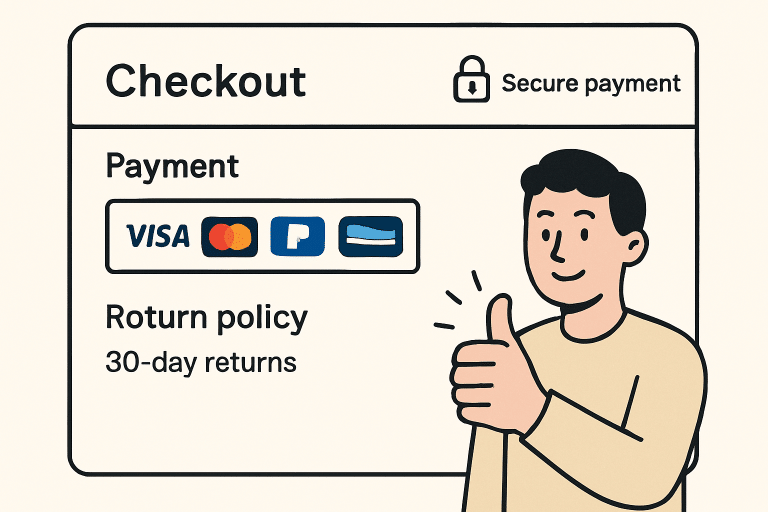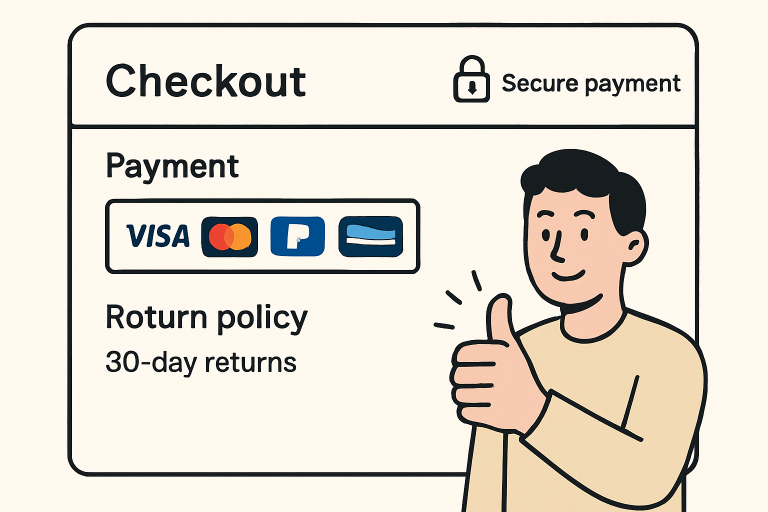Customer trust is the backbone of any successful e-commerce business. At a time when shoppers are inundated with online options, creating a secure, personalized, and user-friendly checkout experience is key to standing out. Adopting strategies like a Shopify checkout comments box can make customers feel heard and valued, improving transparency and communication from the very start of the transaction. These tailored checkout experiences help foster loyalty, reduce cart abandonment, and set brands apart in the crowded digital marketplace.
In the sections that follow, we will explore various practical and effective steps that can be implemented to make the checkout process genuinely personalized, thereby helping to build and reinforce trust with your customers and encourage their loyalty through repeated purchases and positive interactions at every touchpoint.
Understanding the Importance of Personalized Checkout
Personalized checkouts significantly enhance the overall shopping experience by tailoring the process to individual customer preferences. This personalization makes online transactions more seamless and efficient, reducing the time and effort required to complete a purchase. When the checkout page recognizes returning customers through persistent cookies or account login information, it can automatically fill in their preferred shipping addresses, payment methods, and other relevant details, thereby saving them time and minimizing errors. Furthermore, the system can display personalized recommendations and relevant up-sell suggestions based on the customer’s browsing and purchase history, increasing the chances of additional sales.
By speaking directly to previous interactions and preferences, the checkout process fosters a sense of familiarity and trust, which is crucial for building long-term customer loyalty. Recognizing returning customers and offering tailored options can also address their specific needs more effectively, such as suggesting relevant products or offering customized discounts. This targeted approach not only lowers cart abandonment rates—one of the major challenges in e-commerce—but also boosts overall customer satisfaction and retention.
In addition, small acts of personalization, such as auto-filling shipping details, displaying dynamic recommendations, or offering relevant cross-sell and up-sell options, demonstrate that a business values and understands each shopper as an individual. These efforts demonstrate genuine care and attention to detail, which positively influence perceived reliability and encourage repeat business. As e-commerce continues to evolve, integrating advanced personalization techniques—such as AI-driven product suggestions and real-time behavioral insights—will become increasingly important for companies seeking to differentiate themselves and cultivate a loyal customer base.
Implementing Clear Communication Strategies
Trust starts with transparency. When shoppers have confidence in the process, they are more likely to complete their purchases. Customers want to understand the full scope of their purchase without encountering last-minute surprises or hidden fees. Communicating shipping fees, estimated delivery dates, and potential taxes or surcharges early in the shopping journey helps prevent confusion and reduces the likelihood of cart abandonment. Research shows that more than 50% of consumers abandon their carts at checkout due to unexpected costs. By presenting policies and costs upfront, and using clear, straightforward language throughout the entire process, businesses can reassure buyers that they operate honestly and openly, fostering trust and loyalty.
Offering Multiple Secure Payment Options
Modern shoppers increasingly expect flexibility and convenience in their payment options when shopping online or in-store. To meet this demand, it is essential for businesses to offer a diverse range of payment methods. These should include traditional options such as credit and debit cards, as well as popular digital wallets like PayPal, Apple Pay, and Google Pay, along with other regionally favored gateways such as Alipay, WeChat Pay, or other local solutions depending on the target market. Ensuring secure transactions is paramount; prominently displaying security badges, SSL encryption indicators, and trusted payment icons can help reassure customers about the safety of their financial data. Research shows that when consumers can use their preferred payment method, the chance of completing a purchase increases significantly—by up to 30%. This highlights how investing in a variety of secure, user-friendly payment options not only enhances customer experience but also builds trust and loyalty. Offering multiple, trustworthy payment options can effectively reduce cart abandonment rates and increase conversion rates, ultimately driving revenue growth. For more comprehensive insights and strategies, refer to Omnisend’s detailed guide on payment optimization.
Ensuring Transparent Return and Refund Policies
One of the most significant concerns for online shoppers is the uncertainty surrounding returns and refunds. To address this, having a comprehensive, clearly written, and easily accessible return policy is essential. Such a policy not only signals that a store values transparency and customer satisfaction but also helps to build trust and credibility. It should detail specific timelines within which customers can initiate a return, such as within 30 days of receipt, and clearly state the condition the item must be in, such as unused or in its original packaging. Additionally, outlining the step-by-step process for returning items—including how to initiate the return, whether the customer needs to complete a form, or contact customer service—enhances clarity. Explaining the refund process, such as the timeframe for processing refunds once the item is received, and specifying whether customers are responsible for return shipping costs, further reduces ambiguity. Including this information during the checkout process—via prompts or links—demonstrates a customer-first approach, encourages confidence, and makes it easier for shoppers to proceed with their purchase, knowing they are protected and supported throughout the process.
Leveraging Customer Data for Tailored Experiences
Personalized content and recommendations, powered by customer data, have the potential to significantly enhance the checkout experience by making it more tailored and efficient for each individual shopper. Responsible data collection involves gathering information such as previous purchases, browsing habits, location, device type, and even time of day, which allows businesses to craft highly relevant offers, loyalty rewards, and timely reminders that resonate with the customer’s interests and needs. Brands must be fully transparent about how they collect, use, and store this data, and they must adhere to strict privacy regulations, such as GDPR or CCPA, to protect consumer rights. Shoppers increasingly expect personalization that feels helpful and considerate rather than intrusive or surveillant. Therefore, brands should focus on providing a seamless and authentic personalized experience that fosters trust, enhances customer satisfaction, and encourages long-term loyalty. Effective personalization not only drives conversions but also builds a deeper relationship between the brand and the customer, making the shopping journey more engaging and satisfying.
Enhancing Mobile Checkout Experience
Mobile commerce, also known as m-commerce, now accounts for a significant and rapidly growing proportion of online shopping, driven by the widespread adoption of smartphones and tablets. To effectively capture this market, e-commerce businesses must optimize their checkout processes specifically for mobile devices. This involves designing interfaces with larger, easily tappable buttons to accommodate finger navigation, ensuring faster page load times through optimized images and streamlined code, and implementing auto-fill capabilities for forms to reduce typing effort. Additionally, minimizing the number of required fields helps prevent user frustration and cart abandonment.
Creating a frictionless mobile shopping experience is essential, as it reassures customers at every step—from browsing products to completing purchases—and can dramatically reduce bounce and abandonment rates. Ensuring mobile compatibility also benefits the overall perception of an online store, making the entire shopping journey feel more professional, reliable, and trustworthy. This not only enhances customer satisfaction but also fosters brand loyalty, ultimately leading to increased sales and a stronger online presence in a competitive digital marketplace.
Incorporating Social Proof and Testimonials
Shoppers tend to trust businesses that showcase visible, positive feedback from other customers. Embedding authentic customer reviews, star ratings, and user testimonials directly on the checkout page can significantly enhance buyer confidence by providing real-time reassurance about product quality, service standards, and the company’s credibility. This use of social proof serves as a persuasive prompt, reminding potential buyers that others have had satisfactory and trustworthy experiences with the business. Such tactics can effectively reduce cart abandonment rates and increase conversion rates.
Maintaining Consistent Branding Throughout Checkout
Brand consistency influences perception and builds trust. The entire checkout flow should reflect your business’s established color palette, logos, typography, and customer-centric messaging. This not only reinforces recognition but also assures shoppers that their information is being handled by the brand they intended to purchase from, helping to prevent uncertainty or skepticism that might arise from a generic, mismatched payment page. Cohesive branding, from the homepage to the confirmation page, increases brand recall and loyalty long after the transaction is complete.
Every interaction in the checkout process presents an opportunity to reassure, inform, and delight your customers. By investing in transparency, personalization, robust policies, secure payment options, and cohesive branding, e-commerce businesses can turn the final steps of the buying journey into a lasting trust-building experience. Personalized checkouts don’t just increase conversion; they lay the foundation for repeat business and enduring brand loyalty.


